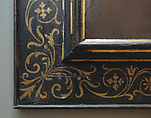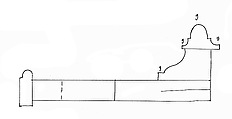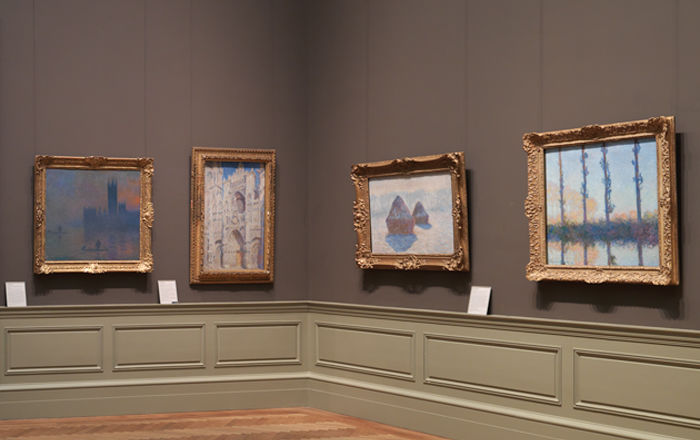Murillo's Portraiture: The soft modeling of light and shadow (known as sfumato) and sensitive realism that became synonymous with Murillo’s name were particularly well suited to genre and religious subjects, images of street urchins, the Immaculate Conception and the Virgin and Child (including The Met’s
43.13). By contrast, Murillo’s accomplishment as a portraitist has been recognized only recently.[1] This is due in part to the small number of such paintings by or attributed to him, which totals around fifteen examples, two of which are in The Met’s collection. Murillo’s earliest independent portrait seems to be his
Juan Arias de Saavedra of 1650 (Duchess of Cadona collection), a half-length image framed in a rich trompe-l’oeil “stone” cartouche that supplied information about the sitter in the form of an inscription and coat of arms. Murillo would employ this format, which relates closely to print culture and perhaps contemporary stucco work, throughout his career and in his two known self-portraits.[2] In their somber, nearly monochromatic arrangements, stark lighting and broad planes of color, Murillo’s early portraits are not far from works by his older contemporaries, particularly fellow Sevillian Francisco de Zurbarán. During Murillo’s only documented visit to Madrid, in 1658, he would have encountered the conventions of grand portraiture by Titian, Van Dyck and Velázquez’s state portraiture—all of which he incorporated during his later career, particularly in his regal full-length depictions of the Andalusian elite. A rare preparatory pen-and-ink drawing for the full-length portrait of an unknown sitter (
65.66.12), dated around 1660, attests to the vitality of Murillo’s creative process in composing images that typically became far more staid in paint. Some of Murillo’s most ambitious portraits were painted shortly after his return to Seville. These include his
Portrait Antonio Hutado de Salcedo, Marquis of Legardo (ca. 1664; Colomer Collection, Madrid) and
Portrait of Justino de Neuve (1665; National Gallery, London) on the grounds of which his early biographer, Antonio Palomino, described Murillo as “an eminent portrait painter.”[3] Murillo’s later portraits also incorporated his distinctive soft brushwork. This is evident in The Met’s portrait of Don Andrés de Andrade y La Cal which, when sold from the French King Louis-Philippe’s collection in 1853 prompted the
Illustrated London News to observe that “The Portraits of Murillo are not numerous, but what exists of them are of great beauty and interest, making one believe that this would have been the field in which he would have been even more preeminently at home than in historical art, had he condescended to adopt it for the field of his operations.”[4]
The Painting: When compared with The Met’s earlier full-length portrait by Murillo (
54.190), this painting from the later 1660s employs both the artist’s newly found technique of softly modeled shadows and the range of props typical of grand portraiture that he had adopted following a trip to Madrid in 1658.[5] As indicated by the earliest of these, his
Portrait of Inigo Melchor Fernández de Velasco (1659; Musée du Louvre, Paris; see fig. 1 above), the court portraiture of Velázquez, Rubens, and Van Dyck provided a new vocabulary, most importantly the rhetorical role of drapery, classical balustrades and pilasters, in elevating the sitter’s status—indeed, back in Seville, Murillo frequently employed these devices somewhat unconventionally across a wider spectrum of society.
Andrade is dressed in the simple black costume typical of male fashion among the
hildago or Spanish noble class, with elegantly slashed sleeves and a
golilla, a severely horizontal, white collar. A sword, carried only by nobility, underscores his status; a hint of black lace along the edge of his hat and the pattern of white dots revealed through a pierced pattern in his black shoes are the most subdued expressions of indulgence. The sitter’s long hair was fashionable in Spain during the second half of the seventeenth century. For the face, Murillo employs his signature technique of softly modeled shadows, which captures a psychological depth that is typical of Murillo’s most successful portraits, including a comparable work of an unknown sitter, today in the Museo del Prado (fig. 2).
The pilaster and balustrade are used by Murillo in several contemporary paintings in order to indicate a generalized, grand setting, but also in the service of a clever conceit that the artist developed in order to integrate and naturalize the sitter’s name and coat of arms. The addition of coats of arms as a kind of stamp, an afterthought atop the picture plane, was standard practice in early modern portraiture (see, for example,
25.110.13). But beginning with his earliest portraits, Murillo seems to have been interested in creating trompe l'oeil carvings, derived from his study of surrounds in printed portraits, in order to solve the problem in a more synthetic, naturalized manner. In a sense, Murillo’s artistic innovation that naturalized a convention is comparable to his means of cleverly humanizing his otherworldly religious subjects (see
43.13). He would employ the same conceit of “carved” coats of arms and other inscriptions in his
Portrait of Justino de Neve (1665; National Gallery, London) and
Portrait of Juan Antonio de Miranda y Ramírez de Vergara (1680; Alba collection, Palacio de Liria, Madrid). In an even more original approach, Murillo’s
Portrait of Antonio Hurtado de Salcedo, Marquis of Legarda (ca. 1664; Colomer collection, Madrid) transposes the coat of arms to a stone that appears as a chunk of ruins in the middle ground of the landscape. As Xavier F. Salomon has observed, Murillo’s interest in antique ruins was probably inspired by sites in and near Seville, a city with a healthy antiquarian culture.[6]
Perhaps the most idiosyncratic feature of this portrait is the large mastiff seated obediently beneath Andrade’s hand, a symbol combining fidelity, strength and nobility. Murillo likely took this regal pairing from Titian’s
Portrait of Emperor Charles V with a Dog (1533; Museo del Prado, Madrid; fig. 3), itself based on a portrait of the monarch by the Austrian court painter Jacob Seigenegger (1532; Kunsthistorisches Museum, Vienna). Van Dyck, whom Murillo studied in Madrid, also used dogs in his full-length male portraits (for example,
89.15.16); Van Dyck’s
Portrait of Wolfgang Wilhem, Prince of Pflaz-Neuburg (ca. 1640; Bayerische Staatgemäldesammlugen, Staatsgalerie, Neubeurg) is particularly close to Murillo’s full-length portrait composition.[7] In Madrid, Murillo could have also asborbed Velázquez’s inclusion of less ferocious animals in hunt portraits of
Cardinal Infante Ferdinand of Austria with a Gun and Dog of 1632 or
Philip IV in Hunting Dress of 1633–34 (both Museo del Prado, Madrid). While the particular kind of dog is difficult to identify, its musculature and hefty collar are clearly intended to suggest its power. The Italian painter known as Guercino depicted a similar animal in what is assumed to be the likeness of a beloved if intimidating pet with a wide collar, the so-called
Aldrovani Dog (ca. 1625; Norton Simon Foundation, Pasadena); however, in Murillo’s portrait, the body type and depiction in profile also leave open the possibility that this is a generalized, even deliberately antiquated animal type such as those found in Antonio Tempesta’s illustrations for the Roman poet Ovid’s Metamorphosis (1608;
51.501.3876) or Tempesta’s series of
Hunting Scenes (1609;
51.501.4081).
Nineteenth-century Celebrity: This painting was especially celebrated in nineteenth-century England.[8] The first certain written reference to the portrait is by the English artist David Wilkie (1785–1841) in 1836 when he encountered it on loan from Sir John Brakenbury to an exhibition at the British Institution, London. Wilkie describes “Brakenbury’s Murillo—The Man with the Dog—Is also in the Gallery: this I saw in the linen-draper’s [the art dealer Bravo’s] house in Seville, and the expression of the head strikes me as much now as it did then. It seems to see you while you look at it.”[9] When Brackenbury sold the painting on August 15, 1837 to King Louis Philippe of France, who was then forming his Galerie Espagnole at the Louvre, the price was said to be over 2,000 pounds. Although the king seems to have actually paid 1,025 pounds, this was still among the most expensive works acquired for Louis-Philippe’s short-lived experiment in anchoring Spanish art in Paris.[10] In 1848, the historian Sir Edmund Head reflected that within Louis-Philippe’s collection, the portrait of Don Andrés de Andrade y la Cal was “the finest of all—equal, indeed, to the portraits of Velazquez,” adding that “it is painful to think that it was ever suffered to leave England and grace the walls of a foreign gallery.”[11] England had, however, its second chance at the work with the highly publicized sale of paintings from the Galerie Espagnole, held in London on May 14, 1853. Prompted by its sale, a reporter for
Illustrated London News observed that "The portrait now in question is very forcible and true in character: in this respect very much after the style of Velasquez; but with more richness of colouring and softness of finish than he bestowed.”[12] As Richard Ford reported of the sale for
The Athenaem, “It was knocked down for 1,020 pounds, amid cheers of the competitors,” selling to Thomas Baring (1799–1873). Ford also gave a probably embellished story of its provenance, suggesting that the Spanish government had tried to ban its export in 1828, but that the production of a copy had allowed for the original to be smuggled to England.[13] By 1854, in Gustav Friedrich Waagen’s
Treaures of Art in Great Britain, he praised it as “one of the finest portraits by the master that I know.”[14] It would be inherited through members of the Baring family until 1927, when it was acquired by The Met.
An early copy of this portrait was probably acquired in Spain by Sir Arthur Hervey-Aston (1798–1859), Envoy Extraordinary and Minister Plenipotentiary at Madrid. It is first mentioned by Stirling-Maxwell in 1848 at Aston Hall, Cheshire. This copy was mistakenly reattributed to Velázquez when sold in 1867, then to Valdés Leal when in the collection of F. W. Cosens, Lewes, who purchased it in 1875.[15] Another close copy by José Gutiérrez de la Vega (1791–1865) was given by Gutiérrez to the Real Academia de Bellas Artes, Madrid, in 1829, at the moment when Murillo’s original was on the art market and about to leave Spain (fig. 4).
The Sitter: Murillo ensured his sitter’s name was made an integral part of this painting. Using his characteristic trompe l’oeil conceit discussed above, Murillo inscribed the architecture represented in this portrait with the coat of arms of the Andrade family, including the motto “AVE MARIA GRACIA PLENA” (the Latin “Hail Mary Full of Grace”) at the top of the pilaster and, at its base, the sitter’s full name, “D [for Don] ANDRÉ / de Andrade y / la Cal.” Unfortunately, archival research—notably by Marcus Burke and Diego Angulo Iñiguez—has uncovered practically nothing about this man.[16] While his identity remains elusive, a lexical quirk in the extensive nineteenth-century historiography of this painting has long misguided research.[17] In 1848, Head described it as “the full-length picture of Don Andreas de Andrade, with his hand on the head of a large dog: the picture is thence known by the name ‘El Perdriguero.’” A
perdiguero (without Head’s “r”) is a kind of large hunting dog, similar to today’s Spanish Pointer (Perdiguero de Burgos) and the epithet is hardly surprising given this distinctive animal’s prominence in Murillo’s painting. That same year, however, Stirling-Maxwell’s
Annals of the Artists of Spain listed it as a portrait depicting “Don Andres de Andrade, Pertigero or verger of the Cathedral of Seville with a white dog,” thereby confusing the terms and introducing an error that has persisted into the most recent literature. While correcting this mistake brings us no closer to Andrade’s actual professional status, it brings the sitter in alignment with his iconography. As early as 1923 and in the recent work of Angulo Iñiguez and Cano Rivero, scholars have noted the unlikely combination of a relatively lowly post within the church and the aristocratic attributes of this portrait.[18]
David Pullins 2020
[1] The fullest treatments are found in Xavier F. Salomon, “‘Apeles sevillano’: Some Thoughts on Murillo’s Portraits” in
Murillo ante su IV centenario: Perspectivas historiográficas y culturales, Benito Navarrete Prieto, ed., Seville, 2019, pp. 201–10; Xavier F. Salomon and Letizia Treves,
Murillo: The Self-Portraits, exh. cat. Frick Collection, New York, 2017; and Ignacio Cano Rivero and María del Valme Muńoz Rubio,
Murillo, IV centenario, Seville, 2018, pp. 333–42. Also see Valdivieso 2010, pp. 241–51.
[2] See Salomon 2019, p. 206; Salomon and Treves 2017, pp. 22–64.
[3] Antonio Palomino,
Lives of the Eminent Spanish Painters and Sculptors, trans. Niña Ayala Mallory, Cambridge, 1987, p. 283.
[4] See Illustrated London News 1853, cited in Stratton-Pruitt 2002, p. 189.
[5] For the most recent and very thorough treatment, see Cano Rivero in Cano Rivero and Valme Muñoz Rubio 2018, pp. 501, 509.
[6] On Murillo’s development of fictive stone frames, see Salomon 2019 and Salomon in Salomon and Treves 2017, pp. 43–56.
[7] Though it is not possible to demonstrate Murillo’s exposure to this specific composition by Van Dyck. Inventory no. 4204. There is also a closely related oil sketch in the same museum, inventory no. 73.
[8] Particularly well outlined Stratton-Pruitt 2002, pp. 189–90.
[9] Letter to Sir William Knighton, May 28, 1836 (see Wilkie 1836).
[10] See Stratton-Pruitt 2002.
[11] See Head 1848.
[12] See Illustrated London News 1853, cited in Stratton-Pruitt 2002, p. 189.
[13]
Athenaeum (May 21, 1853); see Ford 1853 and Stratton-Pruitt 2002, p. 189.
[14] Waagen 1854, p.182.
[15] This copy sold most recently as “follower of Murillo” at Sotheby’s, London, on October 18, 1995, no. 62.
[16] Marcus Burke curatorial file notes, June 1976; Cano Rivero in Cano Rivero and Valme Muñoz Rubio 2018, p. 501. Connection to the family in Seville is, however, indicated by the attendance by both Murillo and a Francesco Andrade, brother of the Holy Charity (Santa Caridad), Seville, on September 18, 1667. See Angulo Iñiguez 1981, p. 313.
[17] Forthcoming Pullins 2020.
[18] Montoto 1923, p. 120; Angulo Iñiguez 1981, I, p. 313; Cano Rivero 2018, p. 501.










